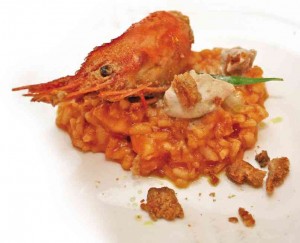
Parting, they say, is such sweet sorrow. Or a delicious one, as in the case of a nine-course dinner served last Friday at The Tivoli, signature restaurant of Mandarin Oriental, Manila.
Having served contemporary European cuisine in a setting inspired by The Tivoli Gardens in Copenhagen for the past 38 years, The Tivoli is soon to be a casualty with the closing of the hotel doors for the last time on Sept. 9.
In fact Tivoli will serve its last lunch tomorrow, July 25. Hence the nine-course degustation dinner, by way of giving its loyal patrons one last chance to savor the ambiance, the food and the service that this elegant restaurant has become known for.
Filipino vestiges
But the menu was not all about The Tivoli’s well-loved dishes, however. The prime rib steak, the lobster bouillabaisse and the millionaire salad to which some customers have understandably formed an emotional attachment. For that, there was the other week’s dinner, prepared by former executive chef Norbert Gandler and his team, who had so gallantly agreed to prepare Tivoli’s specialties one last time.
Rather, last Friday, it was all about the cuisine favored by chef and restaurateur Margarita Fores, who had expressed through a Facebook post her desire to prepare dinner at The Tivoli before its final goodbye. The Mandarin took her up on her wish, and hence a collaboration dinner between her and executive chef Rene Ottlik was organized.
True to Fores’ inclination toward Italian food, the degustation menu leaned heavily toward dishes made popular in that country, with risotto, pasta and cheeses among the main features. But there were also vestiges of Filipino fare, with local ingredients playing a supporting role, or being transformed into an Italian creation.
Such was the case with the first course of red egg sformato, served over a puree of organic Bukidnon asparagus and a garnish of shaved asparagus stalks. Though transformed into a pyramid-shaped timbale, the exquisite flavor of the salted duck eggs was still perceptible, but if that wasn’t enough, three slices of egg whites were there to reinforce the flavor of this local delicacy. A disc of black truffle accented the earthiness of this amuse bouche.
A course of thick mozzarella cheese followed, arranged on a splay of wild arugula leaves and topped with shards of bottarga di muggine, the pressed roe of gray mullet fish. Altogether it was a play of flavors, with the slight bitterness of the arugula and the sweet-salty fish roe complementing the blandness of the mozzarella.
Perfect prelude
It was the perfect prelude to the main courses: slabs of foie gras carpaccio that was almost sinful in its sensuousness, every bite of its velvety flesh being like a tender, lingering kiss. To
assuage the guilt, there were fresh microgreens, edible flowers—blue ternate grown in Tagaytay—as well as orange segments and a dash of coarse salt from Italy.
The risotto that was served next was redolent with the aroma of seafood. An enormous head of river prawn sat atop the flavorful rice, hiding in its inner recesses bits of rich, flavorful red fat just right for the picking.
Inquirer columnist Maurice Arcache, who was at our table, was quite amused by what was described on the menu as the sperm sac of tuna. “What did you do to the tuna?” he teased Fores.
This sperm sac is actually known as bagaybay, Fores explained, and is the male equivalent of bihod, or fish eggs. A sparse sprinkling of roman ciccioli, lard rendering of pig fat, added some texture to the dish.
Perhaps my favorite was the fifth course, pappardelle. The thick fat noodles were drenched in duck ragu, a rich, delectable sauce into which was folded aged Parmigiano-Reggiano cheese and translucent slices of lardo di Colonnata, pig’s fat that had been cured in Carrara marble. Every bite of the pappardelle was sheer bliss— hearty, robust, comforting.
After that I could hardly do justice to the grouper fillet. Served with a fennel-onion confit and salted lemon rind, the fish certainly had its own merits. Perhaps it just had the misfortune of being served after the devastating richness of the pappardelle.
The tenderloin of beef was cooked alla piastra, or in a cast iron pan, and was served with a drizzle of aged Modena balsamic vinegar, porcini mushrooms and native corn kernels—the latter another way of incorporating local ingredients into Italian haute cuisine.
Sharp taste
For dessert, there were Baguio strawberries sweetened with honey from Bicol. The accompanying Gorgonzola cheese had a very sharp taste, and while I do like blue cheese occasionally, this one seemed particularly strong. Perhaps its flavor could have been tamed with a little mixture of the honey (or with a blend of thick cream).
Flaky puff pastry from a deconstructed millefoglie (mille-feuille to the French) on a base of organic egg zabaglione formed the base of the second dessert. In alliance with it were shards of almond-pili, a pool of coconut haleya and balls of Negros apple mango.
Though it was a fitting farewell to a cherished restaurant, it could not be a final goodbye. For long after it has put aside its last frying pan, its last chef’s spoon, The Tivoli will live in the memory of those who have enjoyed the elegance of its setting, savored the taste of its meals, reveled in the excellence of its fine wines.
The Tivoli may be gone, but our taste buds will always remember.
Photos by KIMBERLY DELA CRUZ